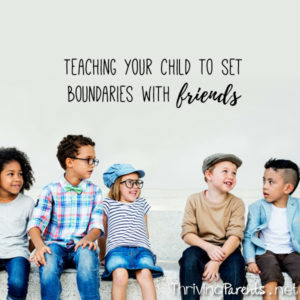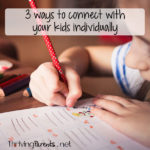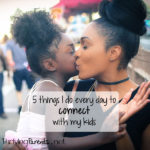I picked up our girls, ages 6, 8, and 9 from school. We weren’t even out of the parking lot when one of them said, “Mom, I have a problem and I need help solving it.”
I love when our kids come to us with problems. It means they trust our judgment and want our advice. It means they feel safe and comfortable confiding in us.
“What’s up?” I asked her, knowing some of our most important conversations happen in the car. (Yours do, too, right?)
“Well, I took my new erasers to school today. Some of my friends asked me to give them one and they wouldn’t stop asking. I didn’t know the best way to say no and get them to understand I mean it.” I wasn’t sure I understood the problem so I asked a few more questions to make sure I was clear on what had happened.

This post contains affiliate links.
Here’s the story:
She took her new erasers to school to show her friends. They’re these new super cute erasers and everyone was excited to see them. A few friends asked if they could have one. Our daughter said no. The friends continued to ask again and again. She felt bad saying no so many times so she gave 2 erasers away to her best friends.
I won’t blame the friends for asking. Elementary school kids don’t yet have awareness of when it is and is not okay to ask for things. I do think they’re old enough to accept a no answer as no, though.
Teaching kids about setting boundaries is more than just teaching them about personal space and what is appropriate or inappropriate.
So how do we teach our kids about setting boundaries with their friends?
- Ask them for possible solutions
The first thing I did is ask each of our girls what they would do in this situation. Each child took turns telling me an option of something they could say about not giving a friend an eraser. “No thanks, these are mine and I want to keep them.” “I’ll find out where we got them so you can get your own.” “I had to give my parents good reasons why they should buy these for me, so I’m not giving them away.” (This last one was very true!)
- Role Play
We then role played the situation. First, I had our kids each take turns being the friend and trying to convince me why I should give them my new erasers. They listened intently while I gave them reasons I would not. Then we reversed roles. I played the part of the friend and tried to convince them why they should give me the erasers.
Role playing may feel “silly” to your child (and maybe you) but it’s an important step. Your child needs to get a feel for the words and needs to know there is power behind them. They need to hear themselves say them and practicing the words will make it easier when the time comes to say them. They can also practice saying NO a little more loudly or forcefully so if their friend isn’t listening to them, they can stay in control of the situation.
- Talk about respect
Talk to your child about the importance of listening to what people are saying. If someone says no to something, it must be honored the first time. Never assume someone is joking or playing around. This will help your child to model what respect looks like for others, whose parents may not be teaching this same important value.
- Go over possible solutions
If their friend isn’t listening and being respectful of what your child is saying, your child has choices they can make. You can create a list of choices with your child. For example:
- Walk away
- Tell a trusted adult (teacher, parent, coach, etc)
- Find something new to do
- Talk to a different group of people
- Put the toy/ object away
- Say how they feel
- “A friend wouldn’t keep asking me to do something I don’t want to do.”
- “Why do you keep asking me to do something I said I didn’t want to do?”
- “I need you to listen to me.”
- “No means NO.”
- “My parents would get mad.”
This last one is always the easy way out.
I let our kids know if their friends aren’t being respectful and listening to what they need, they can always use Matt or me as an excuse. We will gladly be the scapegoat if they need to get out of an uncomfortable situation.
Teaching our kids to set boundaries and be direct with their friends is a skill that will serve them well over their lifetime. By starting to teach them these skills at a young age, it’ll be easier for them to handle peer pressure when it comes to teenage drinking, drugs, and sex.
Setting boundaries with friends is hard for kids to do. It’s easy for them to give into peer pressure. It takes real courage to do and they won’t always be successful – that’s okay. Giving them these tools early on will give them ample opportunity to practice so they’ll be ready when they need them.
Here are some books to help you teach your child about boundaries:
Yes Means Yes: An Introduction to Consent and Boundaries
Sooty & Snow: A book about boundaries
Making Choices and Making Friends
Boundaries: When to Say Yes, When to Say No-To Take Control of Your Life
This one is great for adults!
Boundaries: When to Say Yes, How to Say No to Take Control of Your Life
xoxo
–k
Teaching Kids How to Recharge and Practice Self Care

Teaching kids about self-care is sometimes easier than it is for us adults to practice it. Learn how to talk to them about the importance of it and then begin modeling it yourself!
Putting a Bad Into Perspective for Your Child

Our children imitate what we do much more than they’ll ever act on what we say. Putting your own emotions into a different perspective can help your child learn to process their own.
Click the photo to pin this post and save it for later!





















What a great post! I used role play with my girls when they were growing up. They loved it and would want to do it over and over. I would encourage any parent to do it. Thanks Kristina for sharing.